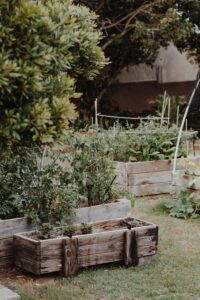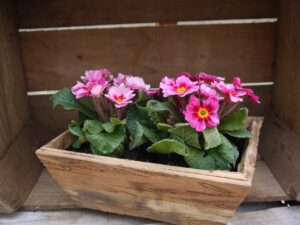Are you dreaming of a vibrant and abundant garden that will be the envy of all? Look no further as we unveil the secrets to creating a lush garden that will leave you feeling like a green thumb guru. This article will share valuable tips and tricks to help you turn your outdoor space into a heavenly oasis of nature’s beauty. From selecting the perfect plants to nurturing them with care, we have got you covered every step of the way. Get ready to roll up your sleeves and embark on a journey of transforming your garden into a breathtaking sanctuary. Gardening can be a rewarding and fulfilling hobby, but it requires careful planning and maintenance to create a lush and thriving garden. This article will guide you through the essential steps to help you make your dream garden. From choosing the right location to attracting beneficial wildlife, we will cover all the tips and tricks you need to know.
Choosing the Right Location
Consider sunlight exposure
When choosing the location for your garden, it is essential to consider the amount of sunlight it receives. Most plants require at least six hours of direct sunlight daily to thrive. Take note of any large trees or buildings that may shade your garden, and choose a location that maximizes sunlight exposure.
Assess soil fertility and drainage.
Good soil fertility and drainage are crucial for a healthy garden. Check the soil in your chosen location to determine its fertility. Look for soil that is rich in organic matter and has a balanced pH level. Additionally, ensure the soil has good drainage to prevent waterlogging, which can lead to root rot and other issues.
Evaluate wind and shade conditions.
In addition to sunlight exposure, consider the wind and shade conditions in your chosen location. Strong winds can damage plants, so selecting a sheltered spot or considering creating windbreaks is essential. Similarly, excessive shade can stunt plant growth, so find a location that balances sunlight and shade.
Selecting Suitable Plants
Determine your gardening zone.
Knowing your gardening zone is essential for selecting plants that thrive there. The United States Department of Agriculture (USDA) has divided the country into gardening zones based on climate conditions. You can choose plants suitable for your specific climate and temperature range by determining your zone.
Consider local climate conditions.
In addition to your gardening zone, it is essential to consider the local climate conditions. Take note of your area’s average temperatures, rainfall patterns, and humidity levels. Some plants are more heat-tolerant, while others thrive in more excellent conditions. You can increase their chances of success by choosing plants that are well-suited to your climate.
Choose plants based on size and growth habits.
When selecting plants for your garden, consider their size and growth habits. Some plants, such as shrubs and trees, can grow quite large and may not be suitable for small gardens. On the other hand, certain plants, like groundcovers and ornamental grasses, can fill in empty spaces and add visual interest. Choose plants that complement each other and fit your garden’s overall design well.
Preparing the Soil
Clear the area of weeds and debris.
Before planting, it is essential to clear the area of any weeds and debris. Weeds can compete with your plants for nutrients and water, so removing them is necessary for their health. Clear away fallen leaves, sticks, or other debris that may interfere with planting.
Test soil pH and nutrient levels.
To ensure your plants have the best possible growing conditions, it is recommended to test the soil pH and nutrient levels. Most plants prefer a slightly acidic to neutral pH, so you may need to adjust if your soil is too acidic or alkaline. Additionally, testing nutrient levels can help determine if any amendments are required to provide optimal plant nutrition.
Amend the soil with organic matter.
Amending soil fertility and structure with organic matter improves soil fertility and structure. Compost, well-rotted manure, and leaf mold are excellent sources of organic matter that can improve the soil’s nutrient content and water-holding capacity. Incorporate these materials into the soil before planting to provide your plants with a nutritious and well-draining environment.
Providing Adequate Watering
Establish a watering routine.
Watering your plants consistently and adequately is crucial for their growth and health. Establish a watering routine based on your plants’ needs and the prevailing weather conditions. Remember that different plants have different water requirements, so it is essential to water each plant accordingly.
Use appropriate watering techniques.
When watering your garden, use appropriate techniques to ensure water reaches the roots of your plants. Avoid spraying water on the leaves, as this can promote the growth of fungal diseases. Instead, aim to water at the base of the plants, allowing the water to penetrate the soil and reach the root zone.
Install an efficient irrigation system.
Installing an efficient irrigation system can be a practical solution for more extensive gardens or areas with limited water availability. Drip irrigation systems are a popular choice as they deliver water directly to the base of the plants, reducing water waste and minimizing the risk of fungal diseases. Consider your garden’s needs and choose an irrigation system that suits your requirements.
Implementing Proper Mulching
Select the correct type of mulch.
Mulching is an important practice in the garden, helping conserve moisture and suppress weed growth. When selecting mulch, choose a type appropriate for your garden and its needs. Organic mulches, such as wood chips, straw, or shredded leaves, are popular choices, as they break down over time, enriching the soil and improving its structure.
Apply mulch to retain moisture.
One of the main benefits of mulching is its ability to retain moisture in the soil. By applying a layer of mulch around your plants, you can reduce evaporation and minimize water loss. This is especially important during hot and dry periods when plants are more prone to drought stress.
Use mulch to suppress weeds.
In addition to conserving moisture, mulch also helps suppress weed growth. A thick layer of mulch can smother weeds and prevent them from sprouting. This reduces the competition for nutrients and water, allowing plants to thrive without interference.
Controlling Pests and Diseases
Identify common garden pests.
Pests can wreak havoc on your garden, so it is essential to identify and manage them effectively. Common garden pests include aphids, slugs, snails, and caterpillars. Regularly inspect your plants for signs of pest infestation and take appropriate measures to control them.
Choose eco-friendly pest control methods.
Regarding pest control, choosing eco-friendly methods that are safe for your plants and the environment is best. Options include introducing beneficial insects, such as ladybugs and lacewings, that prey on garden pests. Additionally, homemade insecticidal soaps and organic pest control products can help manage pest populations without harming beneficial insects.
Monitor plants for signs of diseases.
Diseases can also affect your garden plants, causing wilting, yellowing leaves, and stunted growth. Monitoring your plants regularly and looking out for signs of diseases is essential. If you notice any issues, take action immediately to prevent further spread. Remove affected plant parts, ensure proper pruning, and consider using disease-resistant plant varieties to minimize the risk of infections.
Practicing Regular Pruning
Learn proper pruning techniques.
Pruning is an essential gardening practice that helps maintain the health and appearance of your plants. Learn proper pruning techniques for different types of plants, as each may have specific pruning requirements. For example, shrubs may benefit from regular shaping and thinning, while fruit trees may need pruning to promote optimal fruit production.
Remove dead or damaged branches.
Regular pruning allows you to remove dead or damaged branches, which can be a safety hazard and a potential disease entry point. Removing these branches improves airflow and reduces the risk of disease development. Use clean and sharp pruning tools to avoid causing unnecessary damage to the plants.
Control plant size and shape
Pruning also allows you to control the size and shape of your plants. By selectively removing branches or stems, you can shape your plants to fit your garden’s design and prevent overcrowding. Additionally, pruning encourages branching and promotes a denser, more compact growth habit.
Add Nutrients with Fertilization
Understand plant nutrient requirements.
Plants require essential nutrients to grow and thrive. Understanding their nutrient requirements can help you provide the necessary fertilization. Common essential nutrients include nitrogen, phosphorus, potassium, and micronutrients like iron, magnesium, and zinc. Choose fertilizers that are formulated to meet the specific needs of your plants.
Choose organic or synthetic fertilizers.
When it comes to fertilizers, you can choose organic or synthetic formulations. Organic fertilizers are derived from natural sources, like compost and manure, and provide slow-release nutrients to the plants. On the other hand, synthetic fertilizers are composed of chemical compounds and provide readily available nutrients. Consider your gardening philosophy and choose the type of fertilizer that aligns with your values and preferences.
Apply fertilizers at the right time.
Timing is crucial when it comes to applying fertilizers. Applying fertilizers at the right time ensures that the nutrients are available when the plants need them the most. Follow the instructions on the fertilizer packaging and apply accordingly. Additionally, consider your plants’ specific growing stages and adjust the fertilization schedule accordingly.
Attracting Beneficial Wildlife
Plant flowers to attract pollinators
Pollinators, such as bees and butterflies, play a vital role in your garden’s ecosystem. Plant flowers that provide nectar and pollen as food sources to attract these beneficial insects. Choose various flowering plants that bloom at different times of the year to ensure a continuous food supply for pollinators.
Create habitats for beneficial insects.
Beneficial insects, such as ladybugs and lacewings, are natural predators of garden pests. Creating habitats for these beneficial insects can help control pest populations naturally. Provide shelter, water sources, and host plants for these insects to encourage them to stay in your garden.
Provide food and water sources for birds.
Birds are not only beautiful to watch but also beneficial for pest control. To attract birds to your garden, provide food sources, such as bird feeders or fruit-bearing plants. Additionally, consider providing a water source, such as a birdbath, to offer a refreshing drink for your feathered friends.
Keeping the Garden Weed-Free
Regularly weed the garden beds.
Weeds are the bane of every gardener’s existence and can quickly overtake your garden if left unchecked. Make it a habit to regularly weed your garden beds to prevent weeds from establishing a solid foothold. Pull weeds by hand or use garden tools to remove the entire root system to prevent regrowth.
Use mulch to suppress weed growth.
In addition to regular weeding, using mulch is an effective method to suppress weed growth. A layer of mulch can help smother weeds, preventing them from germinating and growing. Ensure the mulch layer is thick enough to provide adequate coverage and minimize weed emergence.
Consider using weed barriers.
Consider using weed barriers to further prevent weed growth in particularly troublesome areas. Weed barriers are permeable fabrics that can be placed over the soil and under the mulch. They create a physical barrier that inhibits weed seed germination and establishment. Weed barriers can be beneficial in areas with persistent weed issues.
By following these tips and tricks, you can create a lush and thriving garden that will be the envy of your neighborhood. Remember, gardening is a journey of learning and experimentation, so don’t be afraid to try new plants and techniques. With time and patience, your garden will flourish and bring you joy for years. Happy gardening!



